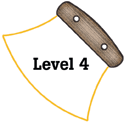
Alaska Science
Key Element A14a
A student who meets the content standard should understand the interdependence between living things and their environments (Interdependence).
 |
Alaska Science A student who meets the content standard should understand the interdependence between living things and their environments (Interdependence). |
|
Performance Standard Level 4, Ages 15–18
|
|
|
|
Sample Assessment Ideas
|
|
|
Expanded Sample Assessment Idea
|
|
Procedure Students will:
Reflection and Revision
|
Levels of Performance |
||
|
Stage 4 |
Student work is complete, and shows evidence of logical reasoning. The investigation and written report show extensive evidence of knowledge related to inter- and intra-community relationships; and how the introduction of exogenous organisms affects the environment. The report explains in detail the chain of events leading to the environmental problem including species competition, animal behavior, and plant growth and development. The report shows detailed evidence of transfer and extension of knowledge in a multi-faceted discussion of natural invasion vs. human-mediated invasion of exogenous species. | ||
|
Stage 3
|
Student work shows evidence of logical reasoning, but may contain minor errors or omissions. The investigation and written report show evidence of knowledge related to inter- and intra-community relationships, and how the introduction of exogenous organisms affects the environment. The report explains the chain of events leading to the environmental problem some aspects of species competition, animal behavior and development, or plant growth and development. The report also shows evidence of transfer and extension of knowledge in a discussion of natural invasion vs. human-mediated invasion of exogenous species. | ||
|
Stage 2
|
Student work is incomplete, or contains errors of science fact and reasoning. The investigation and written report show limited evidence of knowledge related to environmental problems associated with the introduction of non-indigenous organisms or the impact of human-mediated invasion vs. natural invasion. | ||
|
Stage 1
|
Student work is largely incomplete, and contains misconceptions regarding non-indigenous organisms and the environment. | ||
Standards Cross-References
|
||
|
National Science Education Standards Organisms both cooperate and compete in ecosystems. The interrelationships and interdependencies of these organisms may generate ecosystems that are stable for hundreds or thousands of years. (Page 186) Living organisms have the capacity to produce populations of infinite size, but environments and resources are finite. This fundamental tension has profound effects on the interactions between organisms. (Page 186) Human beings live within the world’s ecosystems. Increasingly, humans modify ecosystems as a result of population growth, technology, and consumption. Human destruction of habitats through direct harvesting, pollution, atmospheric changes, and other factors is threatening current global stability, and if not addressed, ecosystems will be irreversibly affected. (Page 186) The distribution and abundance of organisms and populations in ecosystems are limited by the availability of matter and energy, and the ability of the ecosystem to recycle materials. (Page 186) Human populations use resources in the environment in order to maintain and improve their existence. Natural resources have been and will continue to be used to maintain human populations. (Page 198) The Earth does not have infinite resources; increasing human consumption places severe stress on the natural processes that renew some resources, and it depletes those resources that can not be renewed. (Page 198) Humans use many natural systems as resources. Natural systems have the capacity to reuse waste, but that capacity is limited. Natural systems can change to an extent that exceeds the limits of organisms to adapt naturally or humans to adapt technologically. (Page 198) |
Benchmarks Ecosystems can be reasonably stable over hundreds of thousands of years. As any population of organisms grows, it is held in check by one or more environmental factors: depletion of food or nesting sites, increased loss to increased numbers of predators, and disease or parasites. If a disaster such as a flood or fire occurs, the damaged ecosystem is likely to recover in stages that eventually result in a system similar to the original one. (Page 117) Like many complex systems, ecosystems tend to have cyclic fluctuations around a state of rough equilibrium. In the long run, however, ecosystems always change when climate changes or when one or more new species appear as a result of migration or local evolution. (Page 117) Human beings are part of the Earth’s ecosystems. Human activities can, deliberately or inadvertently, alter the equilibrium in ecosystems. (Page 117) |
|
Table of Contents | Return to Alaska Native Knowledge Network